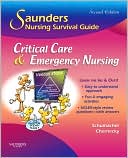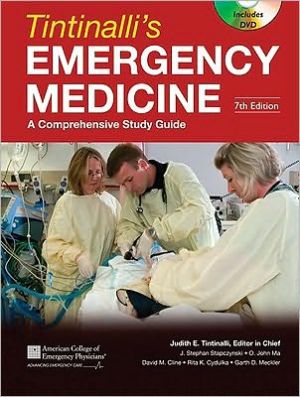Saunders Nursing Survival Guide: Critical Care & Emergency Nursing
Search in google:
Part of the popular Saunders Nursing Survival Guide series, this book prepares you to manage the most common health care problems you'll see in critical care, trauma, or emergency settings. Each chapter is organized from the most immediate and life-threatening conditions to less emergent critical care conditions. Its lighthearted, cartoon-filled approach simplifies difficult concepts, covering each body system in terms of current practice standards.• Consistent headings break content into four succinct areas of review: What (subject) IS, What You NEED TO KNOW, What You DO, and Do You UNDERSTAND? • Clinical terms and shorthand expressions are highlighted, exposing you to terminology used in the hospital setting. • A color insert illustrates concepts and principles of critical care and emergency nursing, including various complications • Mnemonic devices aid your memory and interactive activities help you learn, with exercises including fill in the blank, matching, word jumbles, true/false, and crossword puzzles. • Special icons help you focus on vital information:• Take Home Points help you prepare for clinical rotations. • Caution notes alert you to dangerous conditions and how to avoid them. • Lifespan notes point out age-related variations in signs and symptoms, nursing interventions, and patient teaching. • Culture notes cite possible variations related to a patient’s cultural background. • Web links direct you to Internet resources for additional research and study.• What You WILL LEARN learning objectives help you identify quickly the content covered and goals for each chapter. • NCLEX„¥ examination-style review questions at the end of each chapter allow you to test your understanding of content and practice for the Boards. • Cartoon characters with brief captions help to better explain difficult concepts. • Margin notes are streamlined for ease of use and effectiveness. • Content updates reflect current practice and emergent situations, including increased focus on disaster preparedness, code management, updated ACLS guidelines, and hypertension. Doody Review Services Reviewer:Angela K Sullivan, ADN(University of Arkansas of Little Rock)Description:The authors effectively cover critical care and emergency nursing in a concise, thorough manner that even new graduate RNs can grasp.Purpose:The purpose is to explain difficult concepts in an easy to understand manner to help nursing students master them. Critical care and emergency medicine are two specialties that take years, even for seasoned nurses, to achieve competence. The authors effectively present this difficult material, enabling the most novice professionals to grasp the concepts with ease.Audience:The book is intended for nursing students, as well as for nursing professionals to use as a comprehensive review.Features:The material is organized by body system and each chapter covers the most common health problems nurses are likely to encounter. Illustrations further emphasize key points, as do the subheadings. The "take home" points are interesting and informative.Assessment:The book is successful in presenting difficult concepts in a manner suitable for nursing students, as well as providing NCLEX-style questions for student nurses to reinforce those concepts.
1. Review of Hemodynamics2. Shock Traumaa. Anaphylaxis and Anaphylactic Shockb. Cardiogenic Shockc. Hypovolemic Shockd. Neurogenic Shocke. Septic Shock3. Trauma and Emergency Carea. Rapid Sequence Intubationb. Increased Intracranial Pressurec. Traumatic Brain Injuryd. Acute Hemmorrhage/Penetrating Traumae. Cardiac Tamponadef. Hypothermiag. Near Drowningh. Overdosei. Disaster Preparedness4. Cardiovascular Systema. Anginab. Acute Coronary Syndromec. Heart Failure5. Respiratory Systema. Non-invasive Ventilationb. Mechanical Ventilationc. Pulmonary Embolusd. Acute Respiratory Distress6. Nervous Systema. Seizureb. Status Epilepticusc. Meningitisd. Spinal Cord Injuriese. Spinal Cord Compression7. Gastrointestinal Systema. Gastrointestinal Bleedingb. Bowel Obstructionc. Pancreatitisd. Liver Failure8. Renal Systema. Acute Tubular Necrosisb. Chronic Renal Failurec. Continuous Renal Replacement Therapy9. Endocrine Systema. Hyperglycemiab. Inappropriate Antidiuretic Hormonec. Diabetes Insipidusd. Cerebral Salt Wasting10. Hematolgic Systema. Thrombocytopeniab. Disseminated Intravascular Coagulation11. Integumentary Systema. Burnsb. Necrotizing Fascitis12. Multisystema. Code Management (New ACLS Guidelines; Rapid Response Teams) b. Multiorgan Dysfunction Syndrome








